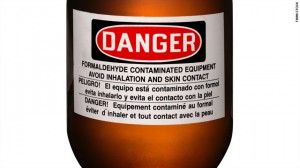By Thomas Tobin, San Diego on December 15, 2015
A new study cases doubt on the longstanding, generally accepted link between formaldehyde exposure and certain disease end points, including Acute Myeloid Leukemia. Within the past few months, Dr. Harvey Checkoway of the University of California at San Diego and six other occupational medicine specialists published an article entitled “Formaldehyde Exposure and Mortality Risks From Acute Myeloid Leukemia and Other Lymphohematopoietic Malignancies in the US National Cancer Institute Cohort Study of Workers in Formaldehyde Industries.” (Harvey Checkoway, PhD, Linda D. Dell, MS, Paolo Boffetta, MD, MPH, Alexa E. Gallagher, PhD, Lori Crawford, MS,Peter SJ. Lees, PhD, CIH, and Kenneth A. Mundt, PhD , J Occup Environ Med. 2015 Jul; 57(7): 785–794.) This article will have a significant impact on those defending chemical exposure matters involving claimed exposure to formaldehyde and other related chemicals. Should other epidemiologists accept the findings of this article, there may be a shift away from claiming formaldehyde at any dose can cause AML and certain other blood-related cancers. The end result will likely put the spotlight back on alleging trace benzene as the potential culprit.

The stated goal of the review in this article was ambitious. The authors of the review considered all available literature addressing the issue of the potential link between exposure to formaldehyde and various hematopoietic disease end points. The article focused on whether formaldehyde is in fact a recognized risk factor in the development of lymphohematopoietic malignancies, including Acute Myelogenous Leukemia (“AML”), Non-Hodgkins Lymphoma (“NHL”), and other related disease end points. The article’s authors concluded, “Insofar as there is no prior epidemiologic evidence supporting associations between formaldehyde and either Hodgkin leukemia or chronic myeloid leukemia, any causal interpretations of the observed risk patterns are at most tentative. Findings from this re-analysis do not support the hypothesis that formaldehyde is a cause of AML.”
These conclusions are significant in matters alleging exposure causing AML, NHL, and other leukemias as disease end points. We have seen a recent uptick in matters alleging lower exposures to formaldehyde in the mortuary and laboratory settings as a cause of AML and NHL. This article questions the very suggestion that AML can be caused by exposure to formaldehyde. It is also suggests that NHL and chronic myeloid leukemia may not be caused by formaldehyde exposure. We expect that there will be increased motion practice challenging general causation in these cases.
Should the focus shift away from alleging formaldehyde as the agent of causation, another likely effect of this study, if accepted, is a return to the use of the argument that trace benzene may cause the disease end points in these cases. In most instances, cases involving formaldehyde exposure often involve exposure to trace levels of benzene in chemicals used simultaneously in various industrial settings. We expect there to be more to come in terms of scientific literature addressing this topic given the potential significant paradigm shift this article promotes.
 Earlier this month, the EPA issued a position paper regarding the risks of glyphosate. Notably, in classifying glyphosate’s cancer risk to humans, the EPA states, “The strongest support is for ‘not likely to be carcinogenic to humans’ at doses relevant to human health risk assessment.”
Earlier this month, the EPA issued a position paper regarding the risks of glyphosate. Notably, in classifying glyphosate’s cancer risk to humans, the EPA states, “The strongest support is for ‘not likely to be carcinogenic to humans’ at doses relevant to human health risk assessment.”
